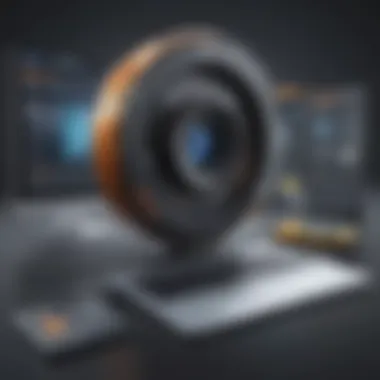Unlock the Potential of Online 3D Video Editing for Immersive Experiences


Software Overview
In this section, we will explore the landscape of 3D video editing software available online. Delving into the intricacies of various programs, we aim to provide a detailed analysis of the key features, functionalities, and pricing structures of these tools. Understanding the software options is crucial for businesses and professionals looking to enhance their visual storytelling capabilities and brand communication through 3D video editing.
When it comes to software for 3D video editing, one needs to consider a plethora of factors, including the intuitive user interface, advanced editing features, and compatibility with different operating systems. The pricing plans and subscription models offered by each software developer play a vital role in the decision-making process, particularly for small to medium-sized businesses with budget constraints.
For individuals seeking comprehensive solutions for 3D video editing online, exploring the various software options is paramount in unlocking the full potential of their creative endeavors. By examining the key features and functionalities of each software, users can make informed decisions to elevate their projects to new heights.
User Experience
User experience is a critical aspect of 3D video editing software as it directly impacts the workflow and productivity of the users. The user interface must be intuitive and user-friendly, allowing for seamless navigation through the different tools and features. Furthermore, the learning curve of the software should be minimal, enabling users to quickly grasp the functionality and capabilities of the program.
In addition to the user interface, customer support options and reliability are essential components of the overall user experience. Timely assistance and reliable technical support can make a significant difference in resolving issues and optimizing the usage of the software. By assessing the user experience aspect of 3D video editing software, businesses and professionals can choose tools that enhance their creative process and workflow.
Performance and Reliability
The performance and reliability of 3D video editing software are crucial considerations for users working on complex projects that demand speed and efficiency. Evaluating the speed of the software in handling rendering tasks, effects application, and overall editing capabilities is essential for seamless workflow and project completion.
Moreover, the uptime and downtime statistics of the software determine its reliability and availability for users. Consistent uptime ensures uninterrupted work progress, while downtime can lead to delays and productivity issues. Integration capabilities with other tools and software applications are also pivotal for enhancing the overall performance and efficiency of 3D video editing projects.
Security and Compliance
Security and compliance are paramount in the realm of 3D video editing online, especially for businesses handling sensitive data and proprietary information. Data encryption and stringent security protocols safeguard against unauthorized access and prevent data breaches that could compromise the integrity of projects.
Ensuring compliance with industry regulations is non-negotiable for businesses operating in regulated sectors, guaranteeing that their 3D video editing processes adhere to legal standards and best practices. Backup and disaster recovery measures further fortify the security infrastructure, offering peace of mind to users by securing their valuable data and projects against potential threats.
Introduction to 3D Video Editing
In the domain of video editing, a paradigm shift has been witnessed with the advent of 3D technology. This section serves as a primary gateway into understanding the transformative power encapsulated within 3D video editing tools. By delving into the intricacies of 3D editing, this article aims to equip individuals from various sectors, including small to medium-sized businesses, entrepreneurs, and IT professionals, with the knowledge necessary to harness the full potential of 3D video editing. Emphasizing the significance of incorporating 3D elements in video content, this section sets the stage for exploring the dynamic landscape of online 3D editing platforms and techniques.
Understanding the Basics
Exploring the concept of 3D video editing
Venturing into the realm of 3D video editing unveils a realm where visual storytelling transcends traditional boundaries. The incorporation of three-dimensional elements adds depth, realism, and a sense of immersion to visual narratives. By engaging viewers on a profound level, 3D video editing opens up new avenues for creative expression and impactful communication. The robust editing capabilities offered by 3D tools enable content creators to craft visually striking masterpieces that captivate audiences and elevate brand communication strategies.
Benefits of incorporating 3D elements in videos
The integration of 3D elements into videos enhances visual appeal and elevates the overall viewing experience for audiences. By leveraging 3D technology, content creators can breathe life into their narratives, effectively conveying messages and eliciting emotional responses from viewers. The versatility of 3D elements allows for seamless integration into various types of video content, ranging from advertisements to educational videos. Despite the complexities involved in 3D editing, the rewards in terms of viewer engagement and brand memorability make it a worthwhile investment for businesses seeking to differentiate themselves in a crowded digital landscape.
Evolution of 3D Editing Tools
Historical overview of 3D video editing software
The journey of 3D video editing software traces back through a rich tapestry of technological advancements and creative innovations. From early rudimentary tools to sophisticated software suites, the evolution of 3D editing tools has revolutionized the way visual content is produced and consumed. By examining the historical trajectory of these tools, one gains a comprehensive understanding of the technological foundations that underpin modern-day 3D editing capabilities.


Emergence of cloud-based editing solutions
As technology continues to advance, the emergence of cloud-based editing solutions represents a monumental shift in the realm of video production. Offering unparalleled flexibility and collaboration opportunities, cloud-based editing platforms empower users to create and edit 3D content seamlessly from any location. The scalability and accessibility of cloud-based solutions make them an indispensable asset for modern content creators, enabling efficient workflows and real-time collaboration among team members.
Significance of 3D Video Editing in Modern Media Landscape
Impact of 3D technology on storytelling
The integration of 3D technology has revolutionized the art of storytelling, allowing creators to weave intricate narratives enriched with visual depth and complexity. By leveraging 3D elements, storytellers can transport audiences into immersive worlds where creativity knows no bounds. The ability to manipulate dimensions and perspectives enhances the emotional resonance of narratives, forging deeper connections with viewers and leaving a lasting impression.
Enhancing viewer engagement through 3D visuals
In a digital landscape inundated with visual content, capturing and retaining audience attention is paramount. 3D visuals offer a compelling way to engage viewers, sparking curiosity and fostering interactivity. By immersing audiences in captivating visual experiences, 3D elements create a memorable viewing journey that sustains viewer engagement and drives brand affinity. The seamless integration of 3D visuals into videos elevates production quality and amplifies the impact of storytelling, setting a new standard for viewer engagement in the modern media landscape.
Exploring Online 3D Video Editing Platforms
Exploring Online 3D Video Editing Platforms within the context of this article is crucial for understanding the landscape of online 3D video editing. In today's digital age, harnessing the power of 3D technology in video editing is paramount for creating compelling visual content. By delving into the realm of online platforms, users can access cutting-edge tools and techniques to enhance their storytelling and brand communication. Exploring various online 3D video editing platforms opens up a world of opportunities for small to medium-sized businesses, entrepreneurs, and IT professionals seeking to elevate their visual content.
Leading Software Solutions
Review of top 3D video editing tools available online
A comprehensive review of the top 3D video editing tools available online is essential for users looking to make informed decisions. These tools play a pivotal role in enabling creators to craft visually stunning and immersive content. By examining each tool's strengths, weaknesses, and features, users can choose the most suitable platform based on their specific editing needs. Understanding the nuances of each tool allows users to leverage their unique capabilities effectively and efficiently.
Feature comparison of popular platforms
Comparing the features of popular online 3D video editing platforms provides users with valuable insights into the strengths and weaknesses of each option. By conducting a detailed feature comparison, users can identify the platform that aligns best with their editing requirements. Factors such as interface design, rendering speed, collaborative features, and export options come into play when evaluating different platforms. This comparison equips users with the knowledge needed to select the platform that best complements their creative process.
User-Friendly Interfaces
Ease of navigation in online 3D editing interfaces
The ease of navigation in online 3D editing interfaces significantly impacts user experience and workflow efficiency. Intuitive interfaces that prioritize user-friendly design elements streamline the editing process, allowing creators to focus on their artistic vision. Navigating through tools and features seamlessly enhances productivity and creative output, making the editing process an intuitive and enjoyable experience.
Customization options for seamless editing
Customization options in online 3D editing platforms empower users to tailor their editing environment to suit their preferences. From adjusting layout configurations to setting personalized shortcuts, customization features play a vital role in optimizing the editing workflow. By offering flexibility and control, these options enable users to create a workspace that promotes creativity and enhances efficiency.
Collaborative Capabilities
Real-time collaboration features for remote teams
The inclusion of real-time collaboration features in online 3D editing platforms fosters teamwork and synergy among remote teams. By facilitating instant communication and simultaneous editing capabilities, these features enhance collaborative workflows. Teams can work together seamlessly regardless of geographical locations, allowing for real-time feedback, brainstorming, and content creation. Real-time collaboration features promote efficiency and creativity, ultimately leading to cohesive and impactful visual storytelling.
Sharing and feedback mechanisms in online platforms
Effective sharing and feedback mechanisms in online 3D editing platforms are essential for facilitating constructive critique and review processes. By providing built-in mechanisms for sharing project files and collecting feedback, these platforms encourage open communication and collaboration. Users can easily share work-in-progress projects, receive comments and suggestions, and iterate on their edits efficiently. These features promote a culture of continuous improvement and mutual engagement within creative teams.


Techniques for Effective 3D Video Editing
In this segment, we delve into the critical realm of 3D video editing techniques, a pivotal component in the creation of visually stunning and engaging content. Understanding the intricacies of effective 3D video editing is paramount for all businesses and professionals looking to captivate audiences in the digital landscape. By mastering these techniques, creators can elevate their storytelling and brand communication strategies to new heights. Emphasizing on the importance of meticulous editing processes, this section will highlight key methods and considerations for achieving excellence in 3D video editing.
Optimizing Visual Depth
Creating depth perception in 3D videos
Creating depth perception is a fundamental aspect of 3D video editing, essential for producing immersive and lifelike visuals. By skillfully manipulating depth cues such as perspective, lighting, and scale, creators can enhance the three-dimensional feel of their videos, drawing viewers into a compelling visual world. The ability to create layered backgrounds and foregrounds adds a sense of realism and depth, enriching the viewing experience. Implementing precise depth perception techniques can significantly impact the overall quality and engagement of 3D videos, making it a valuable tool in the storytelling process. However, achieving the right balance and consistency in depth perception is key to ensuring visual coherence and viewer immersion in the context of this article.
Utilizing parallax effects for immersive visuals
Utilizing parallax effects is a sophisticated technique in 3D video editing, widely acclaimed for its ability to create dynamic and captivating visuals. By incorporating parallax motion, wherein background elements move at a different pace than foreground elements, creators can add a sense of depth and motion to the scene, immersing viewers in a visually stimulating environment. This technique enhances the visual interest and realism of videos, making them more engaging and memorable. However, like any advanced effect, mastering parallax requires finesse and careful execution to avoid overwhelming the audience and detracting from the narrative. Exploring the nuances of parallax effects is crucial for creators seeking to elevate their 3D video editing skills and deliver top-tier visual experiences in alignment with the goals of this article.
Color Grading and Texturing
Enhancing color vibrancy in 3D edits
Enhancing color vibrancy plays a crucial role in enriching the visual appeal of 3D edits, creating vibrant and eye-catching visuals that captivate the audience. By fine-tuning color palettes, saturation levels, and contrast, editors can evoke specific moods and enhance the overall aesthetic of the video. Vibrant colors not only enhance the visual impact but also contribute to establishing a brand's identity and unique style. However, it is essential to strike a balance between bold color choices and maintaining a cohesive visual narrative, ensuring that the colors complement the theme and message of the video effectively. Mastering the art of color enhancement is essential for creators aiming to create visually stunning 3D videos that resonate with viewers according to the article's context.
Texturing techniques for realistic visuals
Texturing techniques are instrumental in creating realistic visuals that transport viewers into immersive digital worlds. By applying texture maps, bump maps, and specular maps, editors can add depth, realism, and tactile quality to surfaces within the video, enhancing the overall visual fidelity. Texture detailing is crucial for conveying materials realistically, whether it be the roughness of a stone wall or the smoothness of polished metal. However, achieving realistic textures requires attention to detail and a nuanced understanding of material properties to ensure consistency and coherence throughout the video. Mastering texturing techniques is essential for creators looking to craft visually compelling 3D videos that resonate with authenticity and visual richness as outlined within the scope of this article.
Audio Integration
Importance of sound design in 3D videos
Sound design holds immense significance in 3D videos, serving as a powerful tool to evoke emotions, set the tone, and enhance the overall viewing experience. Meticulously crafted soundscapes, including music, ambient sounds, and sound effects, can breathe life into the visual narrative, creating a multisensory immersion for the audience. The quality of sound design directly impacts the audience's perception of the video, influencing their emotional engagement and connection with the content. Understanding the role of sound design in storytelling is crucial for creators aiming to deliver comprehensive and impactful 3D video experiences aligned with the objectives of this article.
Syncing audio elements with visual effects
Syncing audio elements with visual effects is a critical technical aspect of 3D video editing, ensuring seamless integration between auditory and visual components for a coherent viewing experience. Synchronizing sound effects, dialogue, and background music with on-screen actions and transitions enhances the realism and continuity of the video, reinforcing the narrative impact. Effective synchronization elevates the overall production quality and viewer engagement, creating a sense of cohesion and immersion in the audiovisual storytelling. However, precise timing and synchronization are paramount to avoid discrepancies that can disrupt the immersion and narrative flow of the video. Mastering the art of audio-visual synchronization is crucial for creators seeking to deliver polished and captivating 3D videos that resonate with audiences in alignment with the essence of this article.
Best Practices for Seamless 3D Video Editing
In the realm of 3D video editing online, the implementation of best practices holds immense significance. These practices serve as a guiding light for creators, ensuring a streamlined workflow and optimal output quality. By adhering to industry best practices, professionals in the field can effectively manage their projects, enhance collaboration, and deliver compelling visual narratives that captivate audiences.
File Management Strategies
Organizing assets for efficient workflow
When delving into the intricacies of 3D video editing, the organization of assets plays a pivotal role in ensuring a smooth and efficient production process. By structuring assets systematically, creators can easily access files, maintain version control, and collaborate seamlessly with team members. This approach not only boosts productivity but also reduces the likelihood of errors and delays, laying a solid foundation for impactful storytelling and brand communication.
Backup and storage solutions for large 3D files
The necessity of reliable backup and storage solutions for large 3D files cannot be overstated in the landscape of online video editing. As projects evolve and grow in complexity, safeguarding precious data becomes paramount. Implementing robust backup strategies and utilizing adequate storage solutions not only protects valuable assets but also ensures continuity in editing processes. While these solutions add a layer of security, they also incur additional costs and maintenance requirements, underscoring the need for a balanced approach in handling large-scale 3D projects.


Rendering and Exporting Tips
Optimizing rendering settings for quality output
The optimization of rendering settings stands as a critical step in the 3D video editing workflow. By fine-tuning rendering parameters, editors can achieve high-quality visuals with enhanced detail and realism. This meticulous process demands a keen eye for detail and a thorough understanding of rendering techniques to bring out the best in 3D projects. While optimized settings elevate the visual appeal of videos, they can also prolong rendering times, necessitating a delicate balance between quality and efficiency.
Choosing the right export formats for diverse platforms
Selecting the appropriate export formats emerges as a key decision point in the 3D video editing journey. Different platforms and devices require specific file formats for seamless playback and compatibility. By tailoring export formats to the intended distribution channels, creators can ensure a consistent viewing experience across various platforms. However, juggling multiple export formats may pose challenges in workflow management and file storage, calling for strategic planning and foresight in catering to diverse audience preferences.
Feedback and Iteration Process
Incorporating feedback loops for iterative improvements
The integration of feedback loops fosters a culture of continuous improvement in 3D video editing projects. By soliciting feedback from stakeholders and viewers, creators can pinpoint areas for enhancement and refine their visual narratives iteratively. This iterative approach not only enhances the overall quality of videos but also promotes collaborative engagement and creative growth within production teams. Embracing feedback as a stepping stone towards perfection, creators can elevate their storytelling prowess and resonate more deeply with their target audience.
Testing videos on multiple devices for optimal viewing experience
The meticulous testing of videos on diverse devices is critical in ensuring an optimal viewing experience across platforms. Viewing videos on different screens and resolutions allows editors to pinpoint potential display discrepancies and fine-tune their projects for universal accessibility. While extensive testing demands time and resources, it reinforces the commitment to delivering high-caliber visuals tailored to audience preferences. By prioritizing viewer experience through comprehensive testing, creators can refine their content and establish a strong foothold in the competitive landscape of 3D video editing online.
Future Trends in 3D Video Editing
In the realm of 3D video editing, staying abreast of future trends is crucial for professionals seeking to innovate and differentiate their work. The shift towards integrating artificial intelligence (AI) into editing tools represents a fundamental transformation in the industry. AI plays a pivotal role in enhancing editing capabilities by automating processes, refining precision, and expediting workflows. This integration streamlines tasks, boosts efficiency, and empowers creators to explore new creative horizons with unprecedented ease and speed. The incorporation of AI not only simplifies complex editing procedures but also elevates the overall quality and output of 3D video projects, marking a significant advancement in the field.
AI Integration in Editing Tools
Role of artificial intelligence in enhancing 3D editing capabilities
Artificial intelligence is revolutionizing the capabilities of 3D video editing tools by revolutionizing efficiency in tasks previously time-consuming and labor-intensive. AI enables tools to analyze content, recognize patterns, and automate repetitive tasks, significantly reducing manual intervention and accelerating the editing process. The ability of AI to predict user preferences, optimize workflows, and improve precision enhances the editing experience, making it more intuitive, intelligent, and user-friendly. By harnessing AI's power, editors can achieve higher levels of productivity, creativity, and output quality, setting new standards for excellence in the industry.
Automated features for streamlined workflows
Automated features in 3D editing tools introduce a paradigm shift in how editing processes are performed. These features streamline workflows by automating tedious tasks, such as video stabilization, object tracking, and scene recognition. By relieving editors of routine work, automated features free up valuable time for creative exploration and decision-making, fostering a more dynamic and efficient editing environment. The precision and consistency offered by automation not only expedite project completion but also ensure a higher level of accuracy and quality, ultimately enhancing the overall editing experience for professionals.
Virtual Reality and Augmented Reality
Exploring the intersection of 3D video editing with VRAR technologies
The fusion of 3D video editing with virtual reality (VR) and augmented reality (AR) technologies heralds a new era of immersive visual storytelling. This integration opens up possibilities for creating interactive, engaging, and experiential content that transcends traditional video formats. By merging 3D elements with VRAR features, editors can transport audiences into captivating virtual worlds, allowing for unprecedented levels of viewer engagement and interactivity. The seamless integration of 3D effects with VRAR experiences creates a synergy that enhances storytelling dynamics, offering an unparalleled avenue for creative expression and audience connection.
Creating immersive experiences for interactive storytelling
The integration of immersive experiences into interactive storytelling revolutionizes the way narratives are crafted and consumed. By leveraging VR and AR technologies, editors can design interactive environments, manipulate spatial dimensions, and engineer sensory-rich experiences that captivate and engage viewers on a deeper level. The ability to blend real-world elements with virtual constructs enables the creation of multi-dimensional narratives that blur the lines between fiction and reality, delivering compelling and unforgettable storytelling experiences. This innovative approach not only redefines the boundaries of conventional storytelling but also propels the evolution of visual narratives into new realms of creativity and immersion.
Enhanced Collaboration Features
Integration of virtual workspaces for real-time editing sessions
The incorporation of virtual workspaces in 3D video editing platforms revolutionizes collaborative practices by enabling real-time editing sessions regardless of geographical constraints. Virtual workspaces provide a shared environment where team members can collaborate, communicate, and co-create seamlessly, fostering a sense of cohesiveness and camaraderie among dispersed teams. By leveraging virtual workspaces, editors can engage in instant feedback exchanges, synchronized editing actions, and concurrent project modifications, ensuring smooth and efficient collaboration regardless of physical distances. This real-time connectivity enhances synergy, productivity, and creativity among team members, facilitating a more dynamic and responsive editing process.
Global connectivity for cross-border collaborations
The facilitation of global connectivity in 3D video editing platforms transforms the landscape of cross-border collaborations, enabling seamless cooperation between geographically dispersed professionals. By transcending physical boundaries, global connectivity fosters a cross-cultural exchange of ideas, expertise, and perspectives, enriching the collaborative process with diverse insights and experiences. The ability to engage in real-time communication, file sharing, and project coordination across continents strengthens international partnerships, promotes cultural diversity, and expands the global reach of collaborative initiatives. Global connectivity not only facilitates smooth cross-border collaborations but also cultivates a rich and vibrant ecosystem of creative exchange and mutual support.







